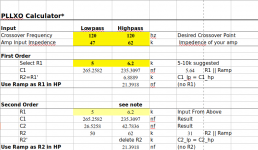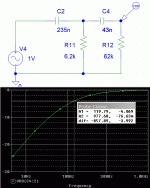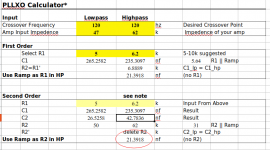maybe your driver have rising response
if so, you need to deal with that, somehow
could a simple tone control do the trick ?
or maybe your phase is wrong
or you have too much overlap causing a peak
if so, you need to deal with that, somehow
could a simple tone control do the trick ?
or maybe your phase is wrong
or you have too much overlap causing a peak
Voice fundementelals are typically 100-200 Hz. There will be some with the droppy 2n order given by a PLLXO.
dave
dave
When I play just the woofers alone there is lots of drums in there but also like cymbals etc. Obviously rolled off.
Old thread but it seemed better to add here than start a new one. Using the PLLXO calc spreadsheet to do a 2nd order high pass filter at 120Hz into 62k amp impedance here is what I get(screenshot attached).
R1 = 6.2k
R2 = 62k
C1 = 235nf
However I am unsure on the value for C2, is it 42nf or 21nf with Ramp as R2? Looks like 21nf with just Ramp but don't see C2 called out specifically on that row.
R1 = 6.2k
R2 = 62k
C1 = 235nf
However I am unsure on the value for C2, is it 42nf or 21nf with Ramp as R2? Looks like 21nf with just Ramp but don't see C2 called out specifically on that row.
Attachments
When I play just the woofers alone there is lots of drums in there but also like cymbals etc. Obviously rolled off.
No crossover or filter is ever 100% efficient. There will always be some output from it's "out of band" response and that is normal and expected behaviour.
It appears to be:
preamp
235nF series
6.2k shunt
43nF series
62k shunt (amplifier Zin)
However this sims as -4dB @120Hz. And you would expect a 10-fold relation between caps. (Making the first cap 430n gives -3dB @ 100Hz.)
Thank you for the sim. Any reason not to follow the 10-fold rule? My target was 120Hz for the highpass.
This type of filter is SO wide and unselective, I would just use Nearest Standard Values and not worry about it coming to -3.02dB @ 120.00Hz.
There is no question that a PLLXO has significant limitations, but if one designs the speaker appropriately they work very well.
dave
dave
There is no question that a PLLXO has significant limitations, but if one designs the speaker appropriately they work very well.
dave
Not sure if that reply was for me. I am using the spreadsheet to calculate a 2nd order PLLXO using Ramp as the total value for R2. Goal is to rolloff a fullrange speaker to integrate with a sub at 120Hz. Just was not sure how to read the spreadsheet to get the value of C2 for R2 = Ramp.
@nd order PLLXOs are kinda droppy, what PRR may have been commenting on, i tend to avoid them.
dave
dave
@nd order PLLXOs are kinda droppy, what PRR may have been commenting on, i tend to avoid them.
dave
Do you think I would be better served by a 1st order PLLXO? These are the FF105WKs in your milliSize box.
Depends how loud you want to play. If you XO above 150 Hz you should be fine — as long as the woofers go high enuff.
In the end, the one that sounds best to you is the one to use.
dave
In the end, the one that sounds best to you is the one to use.
dave
> 2nd order PLLXOs are kinda droppy, what PRR may have been commenting on, i tend to avoid them.
It's not the sharpest knife in the tool-box.
Sometimes you want a rubber hammer to ease the edge of something. And sometimes you need a finely honed razor. If your Six will "handle" 80Hz, but your Fifteen handles it better, then a gentle slope-down from 120Hz may be all you need. If you are feeding the system a thousand watts, the Six will be in distress if you don't SHARP-filter below 120Hz so it won't slap itself (and your ears) crazy. But sharp filters are rapid phase-shifts and need precision fitting between low and high. Gentle 1/2-order filters are kinder and forgiving, as long as the speakers are not strained (or honking) several octaves past crossover.
It's not the sharpest knife in the tool-box.
Sometimes you want a rubber hammer to ease the edge of something. And sometimes you need a finely honed razor. If your Six will "handle" 80Hz, but your Fifteen handles it better, then a gentle slope-down from 120Hz may be all you need. If you are feeding the system a thousand watts, the Six will be in distress if you don't SHARP-filter below 120Hz so it won't slap itself (and your ears) crazy. But sharp filters are rapid phase-shifts and need precision fitting between low and high. Gentle 1/2-order filters are kinder and forgiving, as long as the speakers are not strained (or honking) several octaves past crossover.
Yes, 4" mains supplemented by a 12" sub. I have a 1st order PLLXO now at 120Hz before an ACA for the FF105WKs. Going to build a different amp with higher input impedance so I thought I would try a 2nd order PLLXO to see how it works, ideally I wanted to combine that with a BSC at line level if possible. It's a move from 8 watts to 27 watts so nothing crazy and even with 8 watts I don't lack for volume.
Ultimately this is DIY so I guess I might as well have fun and spend the $10 to try both a 1st and 2nd order PLLXO along with a BSC. Still curious how to read that spreadsheet. If the calculated value for C2 is 43nf when using Ramp as R2 then what is the row labeled "Use Ramp as R2 in HP" with a value of 21nf telling me?
Ultimately this is DIY so I guess I might as well have fun and spend the $10 to try both a 1st and 2nd order PLLXO along with a BSC. Still curious how to read that spreadsheet. If the calculated value for C2 is 43nf when using Ramp as R2 then what is the row labeled "Use Ramp as R2 in HP" with a value of 21nf telling me?
Attachments
A 2nd order high pass with a an amplifier of low input impedance is very difficult (uou need a preamp with VERY low output impedance). In my ACA i socket mounted the input cap so that i can easily swap the input cap so as to use that as the cap in a PLLXO.
dave
dave
I am interested in what is considered "low" for amp input impedance? I am looking at building a PLLXO between an oppo BDP-105 (50 ohm output) and one of my Bryston 4Bs (33k input on balanced XLR). 33k seems a bit low to me, but I am only interested in a 1st order slope so I might be OK here? Would like to roll the mains off around 150Hz @6db/oct.
Also, curious how many folks have done this on balanced inputs? I am assuming here that I will effectively get the average of the 2 slopes, given undoubted variations in the capacitance?
Thanks
Also, curious how many folks have done this on balanced inputs? I am assuming here that I will effectively get the average of the 2 slopes, given undoubted variations in the capacitance?
Thanks
If you are doing a PLLXO the input impedance of the HF amp is a worry only if you are trying to do a 2nd order filter (something i avoid, but i have set a minimum input impedance of about 50k, but how low the preamp output impedance is.
dave
dave
I keep going back and forth between PLLXO and a simple/clean active XO. That Xkitz piece mentioned above looks not too bad, but I hate to put any op amps in the path if I can get away with just passive components. argh, the decisions...
Might end up building up 2 test kits, one passive and one active and just AB them.
Thanks!
Might end up building up 2 test kits, one passive and one active and just AB them.
Thanks!
- Home
- Source & Line
- Analog Line Level
- PLLXO - Am I doing this right?


